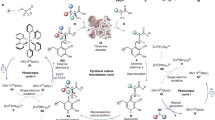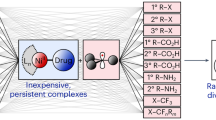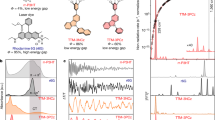Abstract
Sulfur-containing molecules participate in many essential biological processes. Of utmost importance is the methylthioether moiety, present in the proteinogenic amino acid methionine and installed in tRNA by radical-S-adenosylmethionine methylthiotransferases. Although the thiol–ene reaction for carbon–sulfur bond formation has found widespread applications in materials or medicinal science, a biocompatible chemo- and regioselective hydrothiolation of unactivated alkenes and alkynes remains elusive. Here, we describe the design of a general chemoselective anti-Markovnikov hydroalkyl/aryl thiolation of alkenes and alkynes—also allowing the biologically important hydromethylthiolation—by triplet–triplet energy transfer activation of disulfides. This fast disulfide–ene reaction shows extraordinary functional group tolerance and biocompatibility. Transient absorption spectroscopy was used to study the sensitization process in detail. The hereby gained mechanistic insights were successfully employed for optimization of the catalytic system. This photosensitized transformation should stimulate bioimaging applications and carbon–sulfur bond-forming late-stage functionalization chemistry, especially in the context of metabolic labelling.
This is a preview of subscription content, access via your institution
Access options
Access Nature and 54 other Nature Portfolio journals
Get Nature+, our best-value online-access subscription
$29.99 / 30 days
cancel any time
Subscribe to this journal
Receive 12 print issues and online access
$259.00 per year
only $21.58 per issue
Buy this article
- Purchase on Springer Link
- Instant access to full article PDF
Prices may be subject to local taxes which are calculated during checkout





Similar content being viewed by others
References
Trost, B. M. Selectivity: a key to synthetic efficiency. Science 219, 245–250 (1983).
Wender, P. A. & Miller, B. L. Synthesis at the molecular frontier. Nature 460, 197–201 (2009).
Takahashi, N. et al. Reactive sulfur species regulate tRNA methythiolation and contribute to insulin secretion. Nucleic Acids Res. 45, 435–445 (2017).
Kowalak, J. A. & Walsh, K. A. β-methylthio-aspartic acid: identification of a novel posttranslational modification in ribosomal protein S12 from Escherichia coli. Protein Sci. 5, 1625–1632 (1996).
Forouhar, F. et al. Two Fe–S cluster catalyse sulfur insertion by radical-SAM methylthiotransferases. Nat. Chem. Biol. 9, 333–338 (2013).
Stubbe, J. & van der Donk, W. A. Protein radicals in enzyme catalysis. Chem. Rev. 98, 705–762 (1998).
Dunbar, K. L., Scharf, D. H., Litomska, A. & Hertweck, C. Enzymatic carbon–sulfur bond formation in natural product biosynthesis. Chem. Rev. 117, 5521–5577 (2017).
Kolberg, M., Strand, K. R., Graff, P. & Andersson, K. K. Structure, function, and mechanism of ribonucleotide reductases. Biochim. Biophys. Acta 1699, 1–34 (2004).
Fraústo da Silva, J. J. R. & Williams, R. J. P. The Biological Chemistry of the Elements (Oxford Univ. Press: New York, NY, 2011).
Damani, L. A. Sulphur-Containing Drugs and Related Organic Compounds (Wiley: Chichester, 1989).
Dénès, F., Pichowicz, M., Povie, G. & Renaud, P. Thiyl radicals in organic synthesis. Chem. Rev. 114, 2587–2693 (2014).
Posner, T. Beiträge zur Kenntniss der ungesättigten Verbindungen. II. Ueber die Addition von Mercaptanen an ungesättigte Kohlenwasserstoffe. Ber. Dtsch. Chem. Ges. 38, 646–657 (1905).
Hoyle, C. E. & Bowman, C. N. Thiol–ene click chemistry. Angew. Chem. Int. Ed. 49, 1540–1573 (2010).
Stenzel, M. H. Bioconjugation using thiols: old chemistry rediscovered to connect polymers with nature’s building blocks. ACS Macro Lett. 2, 14–18 (2013).
van Dijk, M., Rijkers, D. T. S., Liskamp, R. M. J., van Nostrum, C. F. & Hennink, W. E. Synthesis and applications of biomedical and pharmaceutical polymers via click chemistry methodologies. Bioconjug. Chem. 20, 2001–2016 (2009).
Huynh, V. T., Chen, G., de Souza, P. & Stenzel, M. H. Thiol–yne and thiol–ene ‘click’ chemistry as a tool for a variety of platinum drug delivery carriers, from statistical copolymers to crosslinked micelles. Biomacromolecules 12, 1738–1751 (2011).
Lowe, A. B. Thiol–ene ‘click’ reactions and recent applications in polymer and materials synthesis. Polym. Chem. 1, 17–36 (2010).
Tyson, E. L., Ament, M. S. & Yoon, T. P. Transition metal photoredox catalysis of radical thiol–ene reactions. J. Org. Chem. 78, 2046–2050 (2013).
Tyson, E. L., Niemeyer, Z. L. & Yoon, T. P. Redox mediators in visible light photocatalysis: photocatalytic radical thiol–ene additions. J. Org. Chem. 79, 1427–1436 (2014).
Keylor, M. H., Park, J. E., Wallentin, C.-J. & Stephenson, C. R. J. Photocatalytic initiation of thiol–ene reactions: synthesis of thiomorpholin-3-ones. Tetrahedron 70, 4264–4269 (2014).
Chen, Y., Kamlet, A. S., Steinman, J. B. & Liu, D. R. A biomolecule-compatible visible-light-induced azide reduction from a DNA-encoded reaction-discovery system. Nat. Chem. 3, 146–153 (2011).
Huang, H., Zhang, G., Gong, L., Zhang, S. & Chen, Y. Visible-light-induced chemoselective deboronative alkynylation under biomolecule-compatible conditions. J. Am. Chem. Soc. 136, 2280–2283 (2014).
Nair, D. P. et al. The thiol–Michael addition click reaction: a powerful and widely used tool in materials chemistry. Chem. Mater. 26, 724–744 (2014).
Luo, Y.-R. Handbook of Bond Dissociation Energies in Organic Compounds (CRC Press: Boca Raton, FL, 2003).
Zhao, J., Wu, W., Sun, J. & Guo, S. Triplet photosensitizers: from molecular design to applications. Chem. Soc. Rev. 42, 5323–5351 (2013).
Atta, M. et al. The methylthiolation reaction mediated by the radical-SAM enzymes. Biochim. Biophys. Acta 1824, 1223–1230 (2012).
Stillwell, W. G. Methylthiolation: a new pathway of drug metabolism. Trends Pharmacol. Sci. 2, 250–252 (1981).
Ciamician, G. The photochemistry of the future. Science 36, 385–394 (1912).
Prier, C. K., Rankic, D. A. & MacMillan, D. W. C. Visible light photoredox catalysis with transition metal complexes: applications in organic synthesis. Chem. Rev. 113, 5322–5363 (2013).
Twilton, J. et al. The merger of transition metal and photocatalysis. Nat. Rev. Chem. 1, 0052 (2017).
Skubi, K. L., Blum, T. R. & Yoon, T. P. Dual catalysis strategies in photochemical synthesis. Chem. Rev. 116, 10035–10074 (2016).
Metternich, J. B. & Gilmour, R. Photocatalytic E→Z isomerization of alkenes. Synlett 27, 2541–2552 (2016).
Lu, Z. & Yoon, T. P. Visible light photocatalysis of [2+2] styrene cycloadditions by energy transfer. Angew. Chem. Int. Ed. 51, 10329–10332 (2012).
Blum, T. R., Miller, Z. D., Bates, D. M., Guzei, I. A. & Yoon, T. P. Enantioselective photochemistry through Lewis acid-catalyzed triplet energy transfer. Science 354, 1391–1395 (2016).
Welin, E. R., Le, C., Arias-Rotondo, D. M., McCusker, J. K. & MacMillan, D. W. C. Photosensitized, energy transfer-mediated organometallic catalysis through electronically excited nickel(II). Science 355, 380–385 (2017).
Hopkinson, M. N., Gómez-Suárez, A., Teders, M., Sahoo, B. & Glorius, F. Accelerated discovery in photocatalysis using a mechanism-based screening method. Angew. Chem. Int. Ed. 55, 4361–4366 (2016).
Teders, M., Gómez-Suárez, A., Pitzer, L., Hopkinson, M. N. & Glorius, F. Diverse visible-light-promoted functionalizations of benzotriazoles inspired by mechanism-based luminescence screening. Angew. Chem. Int. Ed. 56, 902–906 (2017).
Benati, L., Montevecchi, P. C. & Spagnolo, P. Free-radical reactions of benzenethiol and diphenyl disulphide with alkynes. Chemical reactivity of intermediate 2-(phenylthio)vinyl radicals. J. Chem. Soc. Perkin Trans. 1, 2103–2109 (1991).
Collins, K. D. & Glorius, F. A robustness screen for the rapid assessment of chemical reactions. Nat. Chem. 5, 597–601 (2013).
Gensch, T., Teders, M. & Glorius, F. Approach to comparing the functional group tolerance of reactions. J. Org. Chem. 82, 9154–9159 (2017).
Snyder, J. J., Tise, F. P., Davis, R. D. & Kropp, P. J. Photochemistry of alkenes. 7. E–Z isomerization of alkenes sensitized with benzene and derivatives. J. Org. Chem. 46, 3609–3611 (1981).
Lowry, M. S. et al. Single-layer electroluminescent devices and photoinduced hydrogen production from an ionic iridium(III) complex. Chem. Mater. 17, 5712–5719 (2005).
Murov, S. L., Carmichael, I. & Hug, G. L. Handbook of Photochemistry 2nd edition (Marcel Dekker, New York, 1993).
Guldi, D. M., Neta, P. & Asmus, K.-D. Electron-transfer reactions between C60 and radical ions of metaloporphyrins and arenes. J. Phys. Chem. 98, 4617–4621 (1994).
Mojr, V. et al. Tailoring flavins for visible light photocatalysis: organocatalytic [2+2] cycloadditions mediated by a flavin derivative and visible light. Chem. Commun. 51, 12036–12039 (2015).
Feng, M., Tang, B., Liang, S. H. & Jiang, X. Sulfur containing scaffolds in drugs: synthesis and application in medicinal chemistry. Curr. Top. Med. Chem. 16, 1200–1216 (2016).
Devendar, P. & Yang, G. F. Sulfur-containing agrochemicals. Top. Curr. Chem. 375, 82 (2017).
Shieh, P. & Bertozzi, C. R. Design strategies for bioorthogonal smart probes. Org. Biomol. Chem. 12, 9307–9320 (2014).
Kolb, H. C., Finn, M. G. & Sharpless, K. B. Click chemistry: diverse chemical function from a few good reactions. Angew. Chem. Int. Ed. 40, 2004–2021 (2001).
Acknowledgements
The authors thank K. Gottschalk, L. Roling, S. Hüwel, W. Dörner and S. Wulff for experimental and technical assistance and R. Honeker, L. Candish and Z. Nairoukh for helpful discussions (all WWU Münster). This work was supported by the Deutsche Forschungsgemeinschaft (Leibniz Award to F.G. and RE2796/6-1 to A.R.) and by the Fonds der Chemischen Industrie (doctoral fellowship to L.A. and Dozentenpreis to A.R.). M.T. thanks SusChemSys 2.0 for general support.
Author information
Authors and Affiliations
Contributions
M.T., F.S.-K., A.G.-S., R.K. and F.G. designed, performed and analysed the catalytic and mechanistic experiments. C.H., A.K. and D.G. designed, performed and analysed transient absorption data and related spectroscopic mechanism studies. L.A. and M.T. designed and performed the biocompatibility screening experiments. M.T., C.H., L.A., F.S.-K., A.R., D.G. and F.G. prepared the manuscript, with contributions from all authors.
Corresponding authors
Additional information
Publisher’s note: Springer Nature remains neutral with regard to jurisdictional claims in published maps and institutional affiliations.
Supplementary information
Supplementary information
Details on chemical compound information and characterization data, experimental details, spectra and mechanistic experiments
Rights and permissions
About this article
Cite this article
Teders, M., Henkel, C., Anhäuser, L. et al. The energy-transfer-enabled biocompatible disulfide–ene reaction. Nature Chem 10, 981–988 (2018). https://doi.org/10.1038/s41557-018-0102-z
Received:
Accepted:
Published:
Issue Date:
DOI: https://doi.org/10.1038/s41557-018-0102-z
This article is cited by
-
Radical thioesterification via nickel-catalysed sensitized electron transfer
Nature Synthesis (2023)
-
Visible light-driven conjunctive olefination
Nature Chemistry (2022)
-
Thiol-Yne click chemistry of acetylene-enabled macrocyclization
Nature Communications (2022)
-
Mechanistic insights into photochemical nickel-catalyzed cross-couplings enabled by energy transfer
Nature Communications (2022)
-
Photochemical single-step synthesis of β-amino acid derivatives from alkenes and (hetero)arenes
Nature Chemistry (2022)



